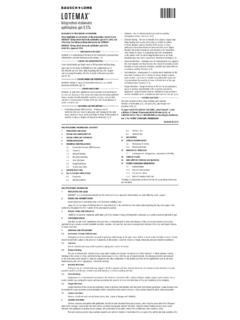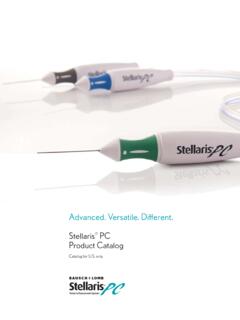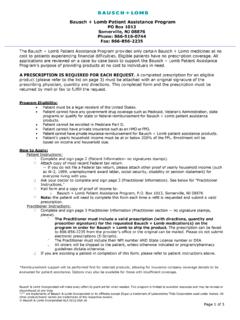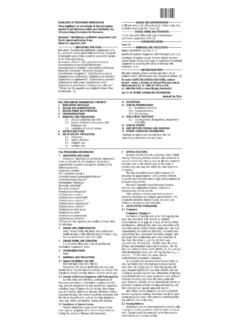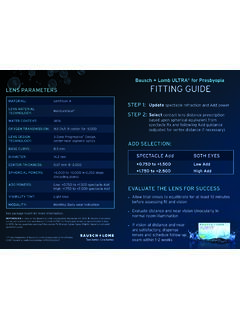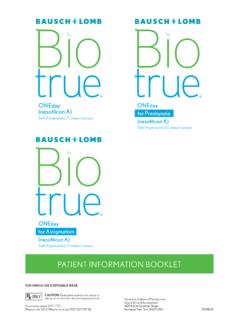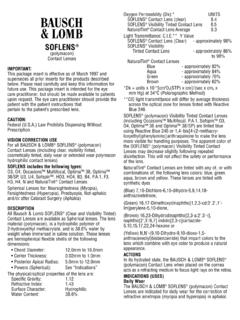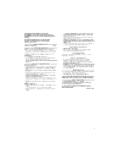Transcription of FULL PRESCRIBING INFORMATION: CONTENTS* 1 …
1 HIGHLIGHTS OF PRESCRIBING INFORMATIONT hese highlights do not include all the information needed to use VYZULTA safely and effectively. See full PRESCRIBING information for (latanoprostene bunod ophthalmic solution) , for topical ophthalmic useInitial Approval: 2017-------------------------INDICATIONS AND USAGE -------------------------VYZULTA is a prostaglandin analog indicated for the reduction of intraocular pressure in patients with open-angle glaucoma or ocular hypertension. (1)---------------------DOSAGE AND ADMINISTRATION ---------------------One drop in the affected eye(s) once daily in the evening. (2)--------------------DOSAGE FORMS AND STRENGTHS --------------------Topical ophthalmic solution: mg/mL latanoprostene bunod ( ) (3)---------------------------CONTRAINDI CATIONS ---------------------------None.
2 (4)---------------------WARNINGS AND PRECAUTIONS --------------------- Pigmentation: Increased pigmentation of the iris and periorbital tissue (eyelid) can occur. Iris pigmentation is likely to be permanent. ( ) Eyelash changes: Gradual changes to eyelashes including increased length, increased thickness and number of eyelashes. Usually reversible upon discontinuation of treatment. ( )----------------------------ADVERSE REACTIONS ----------------------------Most common ocular adverse reactions with incidence 2% are conjunctival hyperemia (6%), eye irritation (4%), eye pain (3%), and instillation site pain (2%). ( )To report SUSPECTED ADVERSE REACTIONS, contact Valeant Pharmaceuticals North America LLC at 1-800-321-4576 or FDA at 1-800-FDA-1088 or 17 for PATIENT COUNSELING information .
3 Revised: 11/2017 full PRESCRIBING information : CONTENTS* 1 INDICATIONS AND USAGE2 DOSAGE AND ADMINISTRATION3 DOSAGE FORMS AND STRENGTHS4 CONTRAINDICATIONS5 WARNINGS AND Eyelash Intraocular Macular Bacterial Use with Contact Lens6 ADVERSE Clinical Trials Experience8 USE IN SPECIFIC Pediatric Geriatric Use11 DESCRIPTION12 CLINICAL Mechanism of Pharmacokinetics13 NONCLINICAL Carcinogenesis, Mutagenesis, Impairment of Animal Toxicology and/or Pharmacology14 CLINICAL STUDIES16 HOW SUPPLIED/STORAGE AND HANDLING17 PATIENT COUNSELING information *Sections or subsections omitted from the full PRESCRIBING information are not PRESCRIBING INFORMATION1 INDICATIONS AND USAGEVYZULTA (latanoprostene bunod ophthalmic solution)
4 Is indicated for the reduction of intraocular pressure (IOP) in patients with open-angle glaucoma or ocular DOSAGE AND ADMINISTRATIONThe recommended dosage is one drop in the conjunctival sac of the affected eye(s) once daily in the evening. Do not administer VYZULTA (latanoprostene bunod ophthalmic solution), more than once daily since it has been shown that more frequent administration of prostaglandin analogs may lessen the intraocular pressure lowering effect. If VYZULTA is to be used concomitantly with other topical ophthalmic drug products to lower intraocular pressure, administer each drug product at least five (5) minutes DOSAGE FORMS AND STRENGTHS VYZULTA is a topical ophthalmic solution containing latanoprostene bunod, WARNINGS AND PigmentationVYZULTA (latanoprostene bunod ophthalmic solution), may cause changes to pigmented tissues.
5 The most frequently reported changes with prostaglandin analogs have been increased pigmentation of the iris and periorbital tissue (eyelid).Pigmentation is expected to increase as long as latanoprostene bunod ophthalmic solution is administered. The pigmentation change is due to increased melanin content in the melanocytes rather than to an increase in the number of melanocytes. After discontinuation of VYZULTA, pigmentation of the iris is likely to be permanent, while pigmentation of the periorbital tissue and eyelash changes are likely to be reversible in most patients. Patients who receive prostaglandin analogs, including VYZULTA, should be informed of the possibility of increased pigmentation, including permanent changes. The long-term effects of increased pigmentation are not color change may not be noticeable for several months to years.
6 Typically, the brown pigmentation around the pupil spreads concentrically towards the periphery of the iris and the entire iris or parts of the iris become more brownish. Neither nevi nor freckles of the iris appear to be affected by treatment. While treatment with VYZULTA (latanoprostene bunod ophthalmic solution), can be continued in patients who develop noticeably increased iris pigmentation, these patients should be examined regularly [see Patient Counseling information (17)]. Eyelash ChangesVYZULTA may gradually change eyelashes and vellus hair in the treated eye. These changes include increased length, thickness, and the number of lashes or hairs. Eyelash changes are usually reversible upon discontinuation of Intraocular InflammationVYZULTA should be used with caution in patients with a history of intraocular inflammation (iritis/uveitis) and should generally not be used in patients with active intraocular inflammation as it may exacerbate this Macular EdemaMacular edema, including cystoid macular edema, has been reported during treatment with prostaglandin analogs.
7 VYZULTA should be used with caution in aphakic patients, in pseudophakic patients with a torn posterior lens capsule, or in patients with known risk factors for macular Bacterial KeratitisThere have been reports of bacterial keratitis associated with the use of multiple-dose containers of topical ophthalmic products. These containers had been inadvertently contaminated by patients who, in most cases, had a concurrent corneal disease or a disruption of the ocular epithelial Use with Contact LensContact lenses should be removed prior to the administration of VYZULTA because this product contains benzalkonium chloride. Lenses may be reinserted 15 minutes after ADVERSE REACTIONSThe following adverse reactions are described elsewhere in the labeling: Pigmentation [see Warnings and Precautions ( )] Eyelash Changes [see Warnings and Precautions ( )] Intraocular Inflammation [see Warnings and Precautions ( )] Macular Edema [see Warnings and Precautions ( )] Bacterial Keratitis [see Warnings and Precautions ( )] Use with Contact Lens [see Warnings and Precautions ( )] Clinical Trials ExperienceBecause clinical trials are conducted under widely varying conditions, adverse reaction rates observed in the clinical trials of a drug cannot be directly compared to rates in the clinical trials of another drug and may not reflect the rates observed in was evaluated in 811 patients in 2 controlled clinical trials of up to 12 months duration.
8 The most common ocular adverse reactions observed in patients treated with latanoprostene bunod were: conjunctival hyperemia (6%), eye irritation (4%), eye pain (3%), and instillation site pain (2%). Approximately of patients discontinued therapy due to ocular adverse reactions including ocular hyperemia, conjunctival irritation, eye irritation, eye pain, conjunctival edema, vision blurred, punctate keratitis and foreign body USE IN SPECIFIC PregnancyRisk SummaryThere are no available human data for the use of VYZULTA during pregnancy to inform any drug associated risks. Latanoprostene bunod has caused miscarriages, abortion, and fetal harm in rabbits. Latanoprostene bunod was shown to be abortifacient and teratogenic when administered intravenously (IV) to pregnant rabbits at exposures times the clinical dose.
9 Doses 20 g/kg/day (23 times the clinical dose) produced 100% embryofetal lethality. Structural abnormalities observed in rabbit fetuses included anomalies of the great vessels and aortic arch vessels, domed head, sternebral and vertebral skeletal anomalies, limb hyperextension and malrotation, abdominal distension and edema. Latanoprostene bunod was not teratogenic in the rat when administered IV at 150 mcg/kg/day (87 times the clinical dose)[see Data]. The background risk of major birth defects and miscarriage for the indicated population is unknown. However, the background risk in the general population of major birth defects is 2 to 4%, and of miscarriage is 15 to 20%, of clinically recognized pregnancies. DataAnimal DataEmbryofetal studies were conducted in pregnant rabbits administered latanoprostene bunod daily by intravenous injection on gestation days 7 through 19, to target the period of organogenesis.
10 The doses administered ranged from to 80 mcg/kg/day. Abortion occurred at doses mcg/kg/day latanoprostene bunod ( times the clinical dose, on a body surface area basis, assuming 100% absorption). Embryofetal lethality (resorption) was increased in latanoprostene bunod treatment groups, as evidenced by increases in early resorptions at doses mcg/kg/day and late resorptions at doses 6 mcg/kg/day (approximately 7 times the clinical dose). No fetuses survived in any rabbit pregnancy at doses of 20 mcg/kg/day (23 times the clinical dose) or greater. Latanoprostene bunod produced structural abnormalities at doses mcg/kg/day ( times the clinical dose). Malformations included anomalies of sternum, coarctation of the aorta with pulmonary trunk dilation, retroesophageal subclavian artery with absent brachiocephalic artery, domed head, forepaw hyperextension and hindlimb malrotation, abdominal distention/edema, and missing/fused caudal embryofetal study was conducted in pregnant rats administered latanoprostene bunod daily by intravenous injection on gestation days 7 through 17, to target the period of organogenesis.
